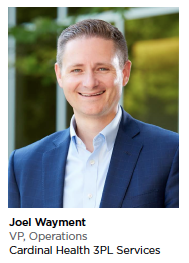 For years, pharmaceutical manufacturers have been challenged to lower the costs of moving pharmaceuticals from point A to point B, while keeping them safe at every step in the supply chain.
For years, pharmaceutical manufacturers have been challenged to lower the costs of moving pharmaceuticals from point A to point B, while keeping them safe at every step in the supply chain.
This challenge is more pronounced today as manufacturers face growing pressures to reduce costs, increase efficiency and optimize resource utilization in their business models. At the same time, product security remains a constant concern and requires ongoing vigilance as part of an overall cost and risk management strategy.
Shared-resources logistics is a novel solution for addressing these challenges. Other industries, such as consumer packaged goods, have used this approach to significantly cut costs. In 2010, Kimberly-Clark teamed up with Colgate to co-load freight and share truck capacity. The goal was to help offset rising transportation costs as they both delivered to the same locations: a limited number of CVS Caremark retail stores. According to Kimberly-Clark, the collaboration cut total truck miles by 10% and line-haul and fuel-haul costs by 18%.
By sharing resources — from warehousing to truck capacity to shipping lanes — manufacturers can optimize their transportation operations, eliminating the high cost of less-than-truckload (LTL) shipments and empty back hauls.
Sharing Resources in Pharmaceutical Distribution
Recognizing an opportunity to apply the benefits of this model to the pharmaceutical industry, Cardinal Health 3PL (Third-Party Logistics) Services developed its own approach to shared-resources logistics.
Known as the Exclusive Pharmaceutical Transportation Network (EPTN), the model combines the best practices of shared-resources logistics: consolidating warehouse space, consolidating freight from different manufacturers and creating more efficient shipping lanes to common destinations.
As part of the development of EPTN, Cardinal Health identified key locations where the vast majority of products were being delivered and designed 12 routes around them. All deliveries are point-to-point ‘milk runs’ — once a product is loaded onto a truck it stays there without being sorted or removed, until unloaded at its destination. Products normally arrive at their destinations within 48 hours or less via routes that deliver to a mix of wholesale, specialty and retail locations in the East, South, Midwest and West. The result is less risk to the product and lower transportation costs for manufacturers.
Building a More Efficient Fleet
EPTN creates efficiencies by eliminating unnecessary touch points in the supply chain and by reducing the need for expedited shipping. In addition to narrowing the shipping lanes, EPTN also adds cost savings through the trucks themselves. In other networks, ambient and cold chain products may each travel in their own truck, even if they are bound for the same location. Or alternatively, if carried by unrefrigerated trucks, cold chain products may be transported in coolers, leading to increased costs associated with excess packaging.
The EPTN solution was to build an entire fleet of trucks refrigerated to 40°F (regardless of the temperature outside), accommodating cold chain products without the need for special packaging and handling. Each truck is calibrated and quality monitored to ensure temperature control. Ambient products can safely travel at 40°F for the entire length of the network’s routes.
Keeping Products Safe
Ensuring the safety of pharmaceutical products from warehouse to destination is another benefit of EPTN. Because of its shared-resource, point-to-point delivery, there are no third-party touches. Unlike traditional shipping methods, products are handled less, which minimizes the potential for damages and claims, as well as product shortages and losses.
The EPTN network also embraces other safety best practices, such as required background checks for contracted team drivers. The trailers and seals are unmarked, and the trucks are always attended. Each truck is also GPS-tracked along the entire route, from origin to destination. An additional safeguard—a geofence—tracks the movements of each truck. If it deviates from the intended route, the carrier is automatically notified and the truck contacted. If necessary, law enforcement is notified.
Proven Results
Since launching the EPTN, manufacturers using the network have experienced an average savings of 10% to 15% in transportation costs, while also lowering costs related to damage products. In addition, on-time departure rates have remained strong at 99.9%. Shared-resources logistics has not only led to cost savings and greater efficiencies for pharmaceutical manufacturers, it has also led Cardinal Health 3PL to work more collaboratively with its customers, which ultimately helps ensure that the patients we serve get the critical products they need, when they need them. (PV)
Cardinal Health 3PL is a third-party logistics supplier that provides a full range of distribution solutions.
For more information, visit cardinalhealth.com/pharma3PL or email Joel at [email protected].


















